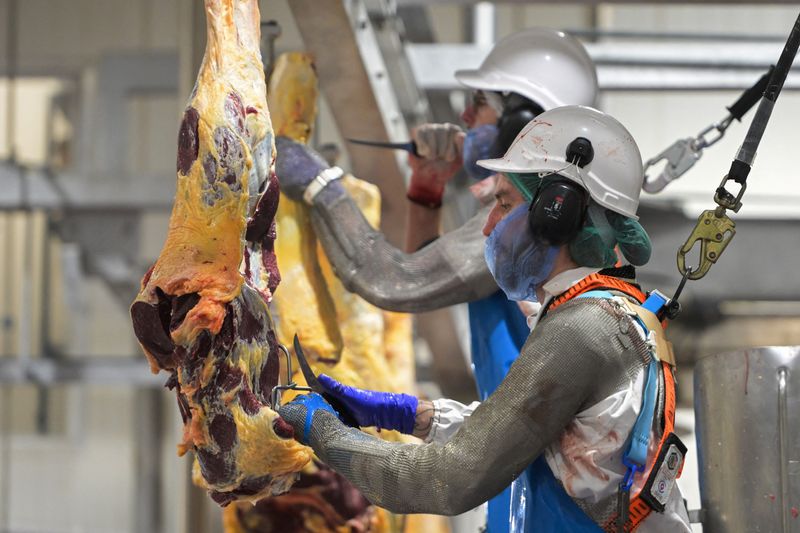By Peter Hobson
COOMA, Australia (Reuters) - In a refrigerated room, around two dozen staff in hats, gloves and blue plastic aprons carve and pack carcasses into boxes within minutes of their slaughter.
The Monbeef slaughterhouse, owned by Bindaree Food Group and located about 100 kilometres south of Canberra, processes some 200 cattle a day, up from 30-40 two years ago, and could ramp up to 220 in the coming months.
"It's an ideal time," said Ryan McDonald, the plant's livestock manager. "Demand out of the U.S. export market is driving the prices up in abattoirs, which then drives the market up for cattle."
A slump in U.S. beef production has opened the door for Australia to export record amounts of meat, growing its market share in North America and Asia and channelling billions of dollars to cattle processors and farmers.
Australia and the United States are among the world's largest beef exporters. Each accounts for a little over 10% of the global beef trade, sending around a million metric tons worth some $8 billion overseas every year, trade data show.
Drought has shrunk U.S. cattle numbers to their smallest since the 1950s, prompting the country to import more beef and export less.
Analysts expect U.S. beef exports to fall further as farmers hold back cattle to breed and rebuild herds, creating a growing market opportunity for rivals.
Most big beef exporters, including top shipper Brazil, have limited ability to take this opportunity either due to production downturns or limited market access.
South American producers face tariffs in the United States and most are barred from shipping to Japan and South Korea, the biggest recipients of U.S. beef, due to rules on foot and mouth disease.
But Australia is flush with cattle after four mostly wet years and has trouble-free trade access to the United States, Japan and South Korea.
Australia's feast will not last forever. Cattle markets move in cycles of de-stock and rebuild and by the late 2020s, Australia's herd will likely be depleted while U.S. cattle numbers should have recovered.
But for now, there's money to be made Down Under, said Ben Theurer, a Barclays analyst in Mexico City.
"Australia is going to have a golden few years. It's going to be very, very profitable," he said.
At the country's top processor, the Australian arm of Brazilian multinational JBS, EBITDA rose by 57% year-on-year to $226 million in the second quarter, financial statements show.
Farmers are winning too. Cattle prices typically tumble when supply of animals is plentiful, but heavy steers are worth around A$3.50 ($2.35) a kilo, data from industry body Meat & Livestock Australia show, below recent peaks but above last year's low of A$2, when farmers struggled to break even.
"We're benefiting," said George King, a farmer near Carcoar in southeast Australia. "Without that international demand, we'd be desperate."
MARKET SHARE
Australia's shipments to the United States have rocketed from an average of 11,000 tons worth $100 million a month in 2022 to nearly 40,000 tons worth $290 million in August, the most for any month since 2015, customs figures accessed via Trade Data Monitor show.
Australia's share of U.S. beef imports has risen from 12% in 2022 to 22% in the first eight months of this year.
Exports to Asia's biggest importers, Japan, China, and South Korea, have also increased as U.S. shipments declined.
Australia's market share has grown from 38% in 2022 to 47% this year in Japan and from 35% to 45% over the same timeframe in South Korea, while the U.S. share fell from 40% to 34% in Japan and 55% to 48% in South Korea.
In China, where Brazil and Argentina are the biggest suppliers, Australia's share has risen from 7% to 8% while the U.S. share slipped from 7% to 5%.
Meat & Livestock Australia predicts that Australia's exports measured by shipped weight will rise from 1.08 million metric tons in 2023 to a record 1.36 million tons this year and 1.37 million tons in 2025 before dipping in 2026.

However, the United States will eventually expand production and reclaim market share, said Angus Gidley-Baird, an analyst at Rabobank in Sydney.
"This isn't a permanent shift," he said. "But it's a good opportunity."
